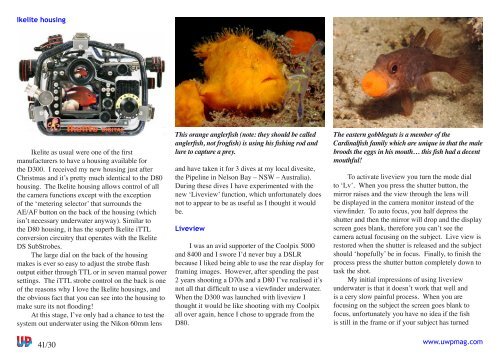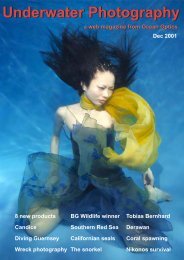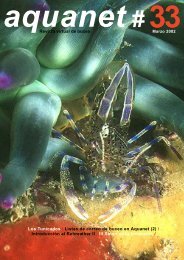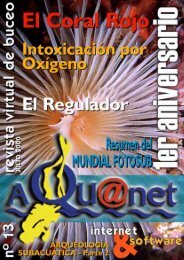Underwater Photography Underwater Photography
Underwater Photography Underwater Photography
Underwater Photography Underwater Photography
You also want an ePaper? Increase the reach of your titles
YUMPU automatically turns print PDFs into web optimized ePapers that Google loves.
Ikelite housing<br />
Ikelite as usual were one of the first<br />
manufacturers to have a housing available for<br />
the D300. I received my new housing just after<br />
Christmas and it’s pretty much identical to the D80<br />
housing. The Ikelite housing allows control of all<br />
the camera functions except with the exception<br />
of the ‘metering selector’ that surrounds the<br />
AE/AF button on the back of the housing (which<br />
isn’t necessary underwater anyway). Similar to<br />
the D80 housing, it has the superb Ikelite iTTL<br />
conversion circuitry that operates with the Ikelite<br />
DS SubStrobes.<br />
The large dial on the back of the housing<br />
makes is ever so easy to adjust the strobe flash<br />
output either through TTL or in seven manual power<br />
settings. The iTTL strobe control on the back is one<br />
of the reasons why I love the Ikelite housings, and<br />
the obvious fact that you can see into the housing to<br />
make sure its not flooding!<br />
At this stage, I’ve only had a chance to test the<br />
system out underwater using the Nikon 60mm lens<br />
This orange anglerfish (note: they should be called<br />
anglerfish, not frogfish) is using his fishing rod and<br />
lure to capture a prey.<br />
and have taken it for 3 dives at my local divesite,<br />
the Pipeline in Nelson Bay – NSW – Australia).<br />
During these dives I have experimented with the<br />
new ‘Liveview’ function, which unfortunately does<br />
not to appear to be as useful as I thought it would<br />
be.<br />
Liveview<br />
I was an avid supporter of the Coolpix 5000<br />
and 8400 and I swore I’d never buy a DSLR<br />
because I liked being able to use the rear display for<br />
framing images. However, after spending the past<br />
2 years shooting a D70s and a D80 I’ve realised it’s<br />
not all that difficult to use a viewfinder underwater.<br />
When the D300 was launched with liveview I<br />
thought it would be like shooting with my Coolpix<br />
all over again, hence I chose to upgrade from the<br />
D80.<br />
The eastern gobbleguts is a member of the<br />
Cardinalfish family which are unique in that the male<br />
broods the eggs in his mouth… this fish had a decent<br />
mouthful!<br />
To activate liveview you turn the mode dial<br />
to ‘Lv’. When you press the shutter button, the<br />
mirror raises and the view through the lens will<br />
be displayed in the camera monitor instead of the<br />
viewfinder. To auto focus, you half depress the<br />
shutter and then the mirror will drop and the display<br />
screen goes blank, therefore you can’t see the<br />
camera actual focusing on the subject. Live view is<br />
restored when the shutter is released and the subject<br />
should ‘hopefully’ be in focus. Finally, to finish the<br />
process press the shutter button completely down to<br />
task the shot.<br />
My initial impressions of using liveview<br />
underwater is that it doesn’t work that well and<br />
is a cery slow painful process. When you are<br />
focusing on the subject the screen goes blank to<br />
focus, unfortunately you have no idea if the fish<br />
is still in the frame or if your subject has turned<br />
41/30 www.uwpmag.com
















